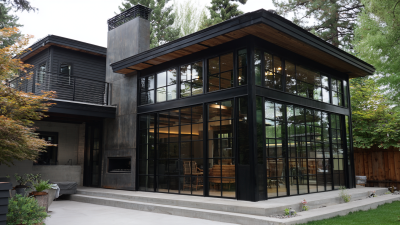Choosing the right home windows and doors is a crucial decision that can significantly impact the aesthetic appeal, energy efficiency, and overall comfort of your living space. With a vast array of options available on the market, understanding the key differences between various styles, materials, and features is essential for making an informed choice. This step-by-step guide will walk you through the critical considerations in the selection process, comparing different types of home windows and doors to help you discover the perfect fit for your unique needs. Whether you're aiming for modern elegance or classic charm, learning about the advantages and disadvantages of each option will empower you to transform your home into a space that reflects your personal style while enhancing functionality.

When selecting the perfect windows and doors for your home, understanding your space is paramount. Factors such as orientation, climate, and energy efficiency should guide your choices. According to a 2022 report by the Department of Energy, windows account for 25-30% of residential heating and cooling energy use. Therefore, choosing energy-efficient windows that provide adequate insulation can dramatically reduce utility bills and increase comfort levels in your home.
Additionally, the architectural style of your property is crucial. A 2021 survey from the American Institute of Architects indicated that homeowners increasingly value aesthetics and functionality, with 70% prioritizing designs that complement the existing layout. When selecting windows and doors, consider both form and function. Options like double-hung windows for traditional homes or sliding doors for modern ones can enhance both the visual appeal and usability of your space. Ultimately, a thoughtful approach to these key factors will ensure that your choices not only look great but also perform effectively for years to come.
When selecting windows and doors for your home, it's essential to consider how they complement your unique architectural style. According to a report by the American Institute of Architects, nearly 60% of homeowners prioritize aesthetics and style compatibility when renovating their spaces. Whether your home boasts a modern, traditional, or eclectic design, aligning your window and door choices with its architecture can enhance its overall appeal and value.
To match your windows and doors to your home’s architecture, focus on key elements such as shape, material, and color. For example, classic colonial homes typically feature double-hung windows and wooden doors with detailed moldings, while contemporary designs often utilize sleek, energy-efficient materials. A recent survey by the National Association of Home Builders found that 78% of home buyers are willing to pay more for a property with quality windows and appropriate door styles, highlighting the importance of making informed choices.
Tips: When choosing windows and doors, consider opting for energy-efficient models, which can lower utility bills by up to 30%, as reported by the U.S. Department of Energy. Additionally, select colors and finishes that not only mirror your home’s style but also resist fading and wear over time. Lastly, involving a professional designer can help tailor these selections to your specific needs, ensuring a perfect balance between functionality and style.
This chart illustrates the popularity of various window and door styles among homeowners. The data indicates that Modern and Contemporary styles are the most favored, while Victorian styles hold less appeal.
When selecting windows and doors for your home, energy efficiency should be a top priority. According to the U.S. Department of Energy, energy-efficient windows can reduce energy bills by 7-15%. This reduction is largely attributed to the insulating properties of modern materials and the low-emissivity (Low-E) coatings that help in managing heat transfer. By minimizing the amount of air leakage and maximizing thermal insulation, homeowners can significantly decrease their reliance on heating and cooling systems, ultimately leading to lower energy costs and a reduced carbon footprint.

Selecting the right doors is equally crucial for maintaining energy efficiency. The American Council for an Energy-Efficient Economy (ACEEE) reports that replacing an old, inefficient door with a new energy-efficient model can lead to a reduction in energy loss of up to 10-15%. Look for doors made of insulated materials or those that feature ENERGY STAR® certification, which indicates compliance with strict efficiency guidelines. Additionally, the importance of proper installation cannot be overstated, as even the best windows and doors can fail to perform if not fitted correctly. Investing in energy-efficient options for windows and doors not only saves money but also contributes to a sustainable living environment.
When selecting windows and doors for your home, understanding the materials available is crucial for making an informed decision. The three most popular options—wood, vinyl, and aluminum—each come with distinct advantages and considerations. Wood, known for its classic aesthetic and excellent insulation properties, provides a warm and natural look. However, it requires regular maintenance to prevent rot and warping, making it less ideal for some homeowners.

Vinyl is a cost-effective and low-maintenance choice, as it resists fading, moisture, and insects. Available in a variety of colors, vinyl windows and doors are durable and energy-efficient, making them a practical option for different climates. On the other hand, aluminum offers a sleek, modern appearance and is highly resistant to the elements. While it may not provide the same level of insulation as wood or vinyl, adding thermal breaks can enhance its energy efficiency. Ultimately, your choice should reflect your aesthetic preferences, budget, and the specific needs of your space.
When it comes to installing windows and doors, ensuring a proper fit is essential for both lasting performance and security. One key tip is to measure accurately before purchasing your new fixtures. Use a tape measure to get the height and width of the existing openings, accounting for any irregularities in the walls. This will help you choose products that fit snugly, reducing the risk of drafts and enhancing energy efficiency.
Another important factor is the choice of materials. Opt for durable materials that can withstand the elements and provide better insulation. For instance, fiberglass and vinyl are excellent options for windows, while steel and fiberglass are top choices for doors. These materials not only enhance performance but also increase security against break-ins.
Lastly, always consider proper sealing and insulation during installation. Use high-quality caulk and weather stripping to fill any gaps around windows and doors. This not only improves energy efficiency by preventing air leaks but also adds an extra layer of security. Well-sealed installations will ensure that your home remains comfortable year-round while keeping unwanted elements at bay.







© 2025 RWC. All Rights Reserved. | Privacy Policy | Contractor’s License Number: 13VH00710200 | Sitemap | Areas Served
